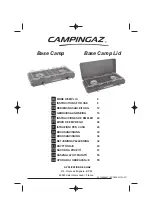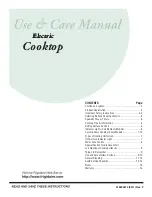
Electric Cooktop Care
16
Cookware Selection
Cooktops with a glass-ceramic surface do not require
special cookware; however, cookware selection will affect
overall cooking efficiency. Use the following guidelines
when selecting cookware:
•
Select cookware with a diameter that matches the
cooking zone. When a pan is placed on the heating
element, it should not extend beyond the ring around
the cooking zone. Cookware for the bridge-zone
element should match the cooking zone size as closely
as possible. Refer to the cookware selection guide.
•
For best results, select medium- to heavy-gauge
metal cookware with a flat, smooth bottom and tight-
fitting lid.
•
Select cookware made of materials with good heat
conductivity, such as aluminum and copper. These
metals are sometimes found “sandwiched” between
the inner and outer layers of the pan.
•
Cast iron and especially glass cookware will be slower
to heat. Glass cookware should only be used as
recommended by the cookware manufacturer.
•
Cover pans while cooking; covers improve cooking
efficiency. Water boils faster, using less energy, and the
kitchen stays cooler.
•
Select high-sided (deep) pans rather than ones with
very wide bases and low sides. High sides will
minimize boilovers.
•
Avoid pots and pans with uneven or rounded bottom
surfaces. Some specialty cookware such as woks,
pressure cookers, canning modules and deep fat fryers
must be carefully selected to meet the guidelines
above.
ELEMENT
ZONE
DIAMETER
TRIPLE-ZONE
Inner
6" (152)
36" Cooktops
Middle
8" (203)
Outer
12" (305)
TRIPLE-ZONE
Inner
5" (127)
15" and 30" Cooktops
Middle
7" (178)
Outer
10" (254)
DUAL-ZONE
Inner
5" (127)
36" Cooktops
Outer
9" (229)
SINGLE-ZONE
8" (203)
30" and 36" Cooktops
SINGLE-ZONE
6
1
/
2
" (165)
All Cooktops
BRIDGE-ZONE
8" (203) x 17" (432)
30" and 36" Cooktops
COOKWARE SELECTION GUIDE





































